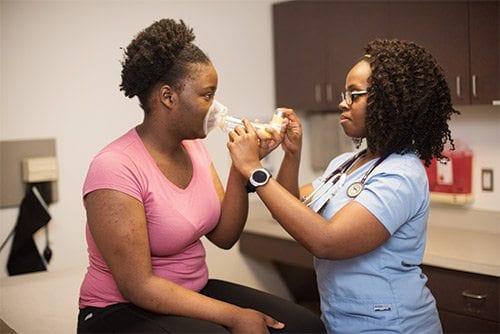
JHENANE JOSEPH more affectionately known as JJ, is a pediatric nurse at Codman Square Health Center. Much of her time is spent teaching kids with asthma how to take their medicine correctly.
One wonders why a nurse has to devote that much time to something that at least with other illnesses is pretty basic. A kid gets sick, takes a pill or gets a shot. With asthma it’s not that easy.
Medication for asthma is usually administered through a metered-dose inhaler. The purpose of the inhaler is to deliver a shot of medicine straight to the lungs. The inhaler is composed of a cylinder of medicine, a valve that measures the correct dose and the mouthpiece. The National Heart, Lung and Blood Institute recommends that children younger than five use a spacer or a mask to help direct the medicine more easily into the lungs.
Regardless of the method used, inhalers are tricky to master. A study published in the New England Journal of Medicine Journal Watch found that of the 54,000 patients evaluated, only one-third used their inhaler correctly. Poor technique is a common cause of uncontrolled asthma.
The proper technique is to breathe slowly and deeply when inhaling the medicine, then hold the breath for 10 seconds to ensure the medicine reaches its target and not stay in the mouth. The most common mistakes mentioned in the study were failure to maintain a full, slow, constant inspiration, and failure to hold one’s breath for the required time after the dose of medicine.
That’s where JJ steps in. Her patients have not always been properly trained, and have as a consequence gone through a series of medications. “A’s not working. B’s not working — all because education was not given,” she explained. She starts with the basics and explains what asthma is and what it does to the body. Each visit is a teaching session.
Then comes the lesson on the inhaler. She has seen her share of the mistakes. Not inhaling is the most common error. Incorrect placement is another. You have to place the inhaler above the tongue under the top teeth and close your lips tightly around the mouthpiece. If you don’t the meds wind up in the air instead of the lungs, she explained. “You’re supposed to feel it,” she said. Once patients do it right they can feel the difference.
Some people prefer to use a spacer, a holding chamber for the medicine that attaches to the inhaler. Medicine is sprayed into the spacer instead of directly into the mouth, but you still breathe in slowly and hold your breath for 10 seconds.
Sometimes patients don’t know the symptoms of asthma so they don’t know when to take the medicine. Still others are on the opposite spectrum. Some with anxiety go through their inhaler quickly. They’ve taken all the meds within two to three weeks. “That’s too much,” she explained. In general, one inhaler is enough for 200 puffs of medicine. If the person needs two puffs a day it should last for 100 days.
By the fourth visit her patients usually have the technique down pat, but she keeps seeing them until they are comfortable. Age is a factor. Some as young as five can master the technique, but the typical age of expertise is eight or nine. Discharges are rare. “I see them at least every three months,” she explained.
JJ said she also relies on peak flow meters, portable hand-held devices used to assess lung function, by measuring how fast a person can push air out of the lungs. ”You have to know your best peak flow,” she said. “It’s a great teaching tool and helps [you] understand the disease.” The measurements on the meter can alert you when your asthma symptoms are worsening. Sometimes changes in your status occur even before you feel them.
JJ said she knows she has succeeded when her patients take ownership of their asthma and do their part to keep it under control. She sums up what she does in three words. “Teaching, teaching, teaching,” she said.






